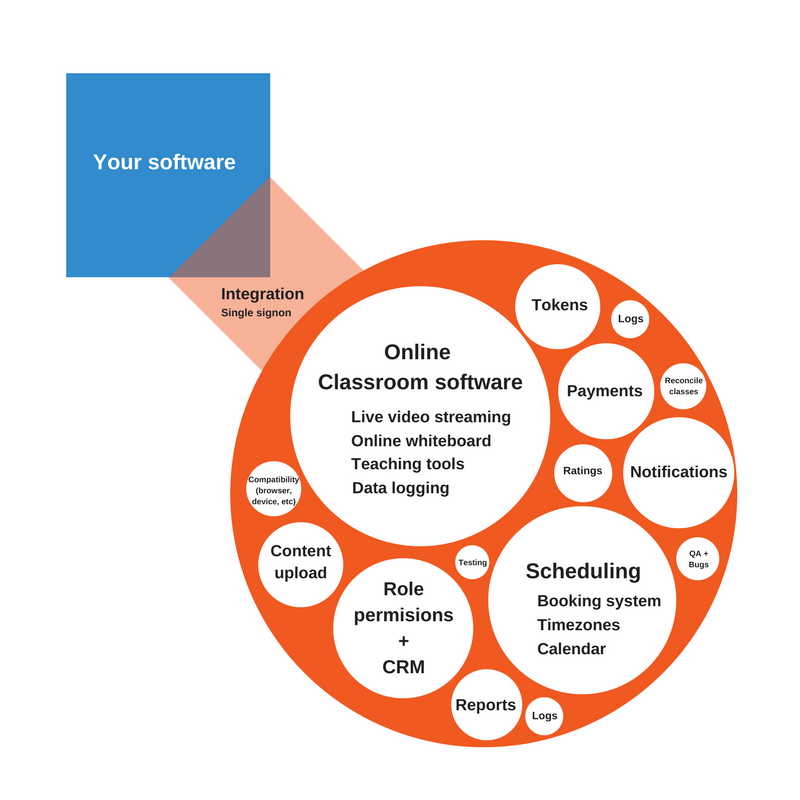
We're approached by top language learning companies like Babbel.com that have wonderful core product and are wanting to add live online tutoring. The million dollar question is... Do you build your own software solution from scratch or take advantage of someone else's?
This article aims to help your decision making process and feel comfortable with whichever decision you decide to make. We'll start by looking at what's actually involved in building a live online teaching platform...
ONLINE SCHOOL SOFTWARE FOR LANGUAGE APPS
There is a lot that is involved in building an online live tutoring platform. A common misconception is that live tutoring is just about the live video streaming. WebRTC is the breakthrough technology that is allowing high quality video/audio through the browser but is harder than it looks.
Firstly, you need to check that the user is allowing the browser to access the camera and microphone. It's very common for users to overlook this...so what about your equipment check before the class? What about troubleshooting? What about technical support?
Now, you've got live video, how are you going to provide a better experience than a Skype class? You're going to have to build or find an elegant online whiteboard solution that is made for language learning. It needs to be simple for teachers to intuitively understand and not be weighed down with a whole bunch of irrelevant features that clutter the user experience. It needs to sync properly, allow multi-media (video, audio, YouTube) and be world-class.
Let's assume you have that...how do your students book a class with a teacher. Student need to see when classes are on or be able to select from teacher availability. Students will be across the world so you'll need to think about managing different timezones? Then there's the notifications to remind, confirm, cancel, reschedule classes. Or you need to think about adding another external scheduling software like Calendly which isn't cheap if you want one account for each teacher...How do you get the oversight of what all teachers are doing? Does this process represent your brand and image? Does this workflow cause friction, raise drop-off rate and limit your business opportunity?
Now that you've got a system that delivers the class, allows for scheduling, how are you going take payments? Rate and monitor teacher performance? Reconcile classes taken vs paid for? Deal with compatibility issues on different browsers, devices and types of content?

Once you've solved all of these requirements, you still need to out-innovate your competition and maintain the new platform you've created.
So do you build or buy software?
UPSIDES OF BUILDING YOUR OWN ONLINE SCHOOL SOFTWARE
There are upsides for building your own online school platform. You have full control and responsibility for the new build. You can create the platform any way you like. You can modify the flow at will and add custom features at will. These are opportunities but come with a price tag.
DOWNSIDES OF BUILDING YOUR OWN ONLINE SCHOOL SOFTWARE
As you can imagine, it is not an insignificant task to create your own online tutoring or teaching platform. There are a number of costs.
It's slower to build from scratch
As an experienced project manager, you know that the 80/20 rule is going mean that building a solution from scratch is going to take twice as long and three times the price.
Building takes a long time because you need to decide on the concept, scope out the full project, build, test, learn, rebuild, innovate, repeat.
You may feel confident that it is worth the effort but your team's time is expensive. The market and opportunity is constantly changing.
-
How central is live online teaching to your business strategy?
-
If your competitors are simply using an existing software...what is the cost of that head-start?
-
How much revenue do you "miss out" on while you're in the 6 - 18 month build phase?
-
Where is the live tutoring market going to be in 12 months time once you've built it?
-
Does your company have the patience and resources to keep your focus?
Aside from the opportunity costs, there are of course the real financial costs that you'll need to find extra budget for...
It's expensive
Development costs are steep. If you have a big enough team and a fantastic project manager, there's a chance you could get a prototype ready in 3 months and an MVP ready in 6 months...
Here's an outline of the skeleton crew you'll need:
-
You or a 'visionary' @ your price per hour x full time
-
Project manager full-time @ $25 (in India) - $62.5 p.hour (in USA) => $48,000 - $120,000
-
2 x backend developers full-time (building, bug-fixing, innovating) => $40,000 - $180,000
-
1 x frontend developer full-time => $20,000 - $90,000
-
1 x QA / Tester full-time => $20,000 - $80,000
-
0.5 x Designer part-time => $5,000 - $40,000
=> Financial Cost = $133,000 - $420,000
There is always the temptation to outsource your development in a low-wage country like India or Pakistan but are these developers going to interpret your vision? Are they going to be able to think fast and think ahead? How invested are they in this project?
I've done this myself with a previous startup. I was really lucky in finding an "affordable" and high quality development agency in India. The project manager was great and the team was communicative and said they believed in the vision.
3 years later, hundreds of thousands of dollars in debt...where was my reliable, elegant, world-class software to change the world? No-where to be seen. Despite my team's best intentions, I found myself with an ok software that worked most of the time. I learned the hard way that more often than not, you get what you pay for.
It's risky
There is a lot more risk in creating your own solution than from purchasing or subscribing to an existing.
As Uncle Ben from Spider-man says so elegantly, "With great power comes great responsibility". If something goes wrong, it up to you and your team to fix it.
Firstly, you're responsible for the technical risks. I can tell you from experience, there is a lot that you need to consider when it comes to building an online classroom.
Think how many types of browsers there are: Chrome, Firefox, Safari, Opera...
Think how many types of platforms there are: Desktop, tablet, mobile...
Think how many brand/types of devices there are: Apple, Samsung, Xiaomi...
Think how many types of users there are: kids, university students, working adults...
Think how many types of teachers there are: tech-savvy or tech-phobic teachers?
You are responsible for ensuring a world class experience for every combination...
Secondly, there are market, business and technology risks that you are especially exposed to while building your MVP.
-
What if the market changes?
-
What if technology advances?
-
What if a key team member leaves during the build process?

You or your project leader has to be ok with this risk and feel confident that the extra costs will pay off...
Have you thought how many 'seats' or 'classes' do you need to sell to make this profitable?
UPSIDES OF USING AN EXISTING ONLINE SCHOOL SOFTWARE
Most of the downsides of creating your own school management software can be mitigated by using an existing technology.
It's faster to employ a plug-and-play solution
Speed to market is becoming one of the most important ingredients to success in our hyper-speed global economy. If you can get to an under-served market first, you can acquire customers much cheaper, capture much of the market and make it much more difficult for your competitors to displace you.
There are extra benefits in terms of good PR and showing your business is a market leader.
The most important benefit is that you can start making money from day 1.
It's cheaper
There are a couple of key metrics in teaching live online classes:
-
Revenue per hour
-
Cost per hour (teacher)
-
Cost of acquiring a customer (marketing)
-
Cost of technology (e.g. LearnCube or your own)
-
Lifetime value of student (i.e. # of student hours)
Let's do some high level cost-benefit analysis since it's critical to ensure you have a viable business.
Revenue per class/hour: $30
Cost per class/hour (teacher): ($20)
Operating profit: $10 per class or 33% margin
So work this out over a year:
Total number of classes per month: 4,000 (4 classes x 1,000 students)
Revenue per month: $120,000 ($30 x 4,000)
Costs of teachers per month: -$80,000 ($20 x 4,000)
Operational profit per month: =$40,000
Operational profit per year: =$480,000
That looks good but there are three incredibly important metrics of success in live online language teaching:
Lifetime value of a customer
Cost of acquiring a customer (marketing)
Cost of administration (over that lifetime)
Your development costs and product influence these three metrics significantly.
Our customers, Iboux.com and Babbel.com, sell packs of classes (5 - 20 classes) for around $20 per class.
Let's say the average number of classes for a student was 8. So the lifetime value (revenue) of a customer would be $240 with a profit margin of 30% = $72 per student.
It would seem realistic to invest $1 for every $5 you make, so let's say the cost of cost of acquiring a customer in Google Ad, Facebook ads, partnerships is $6.60 per customer.
Operational profit per year: $480,000
Costs of customer acquisition: $40,000 (6000 new students x $6.6)
Profit - customer acquisition: =$440,000
Now, this is the important part for you...What is the cost of technology?
I'll start with the cost of LearnCube since we're the only online classroom software that is purpose-built for teaching languages live and online.
Setup cost (standard): $947
Monthly costs: 1000 active students x 0.697 = $697
Annual costs of LearnCube: $9,311
The costs of LearnCube are about 0.0065% of your revenue
The alternative is you build your own:
Setup cost: $420,000 - $1,000,000
Monthly costs for live video: $2,160
Annual costs of LearnCube: $25,920 + $420k to $1M
The costs of creating your own software are about 64.5% of your revenue (remember you'd have maximum 6 months of revenue in that first year i.e. $720k)
Even in your second year, assuming you could halve your development costs it would be 32% vs 0.0065% of your revenue. That's the $436,609 cost of developing your own software.
Did I mention the extra costs of translating your software into the languages of your target students? English, German, Spanish, French, Italian, Portuguese, Chinese, Japanese, Vietnamese, Thai, Russian, etc...
It's less risky
If you choose to go for an online school software provider, you're massively reducing your risk.
Not only do you avoid the extra $420,000 of sunk costs in developing your own software, but you're faster to market, can learn quicker and have access to the experts in WebRTC technology.
Forget bug-fixing, fighting hackers, maintaining servers, learning a new technology stack, adding new features and playing catching-up on your competitors. Your investment is 4% a big so you're more likely to be profitable in month 1 rather than month 18...
Saying that you've still got to choose the right technology provider and team...
DOWNSIDES OF BUYING OR SUBSCRIBING TO AN EXISTING ONLINE SCHOOL SOFTWARE The platform and systems are shared so you do lose some ability to customise your user experience.
You rely on a provider that can either integrate with your existing systems or provide a simple virtual classroom API.
It’s also not as easy to experiment or try new features or ideas.
SUMMARY There are real tradeoffs to consider with either building an online school from scratch or choosing to use someone else's.
It basically comes down to your development capacity + need for customisation/ownership vs speed-to-market, profitability + reliability?